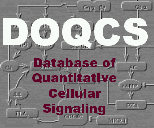
|
Enter a Search String | | Special character and space not allowed in the query term.
Search string should be at least 2 characters long. |
Reaction List for pathway LacZ (Pathway Number 141) | | Kd is calculated only for second order reactions, like nA+nB <->nC or nA<->nC+nD, where n is number and A,B,C,D are molecules, where as for first order reactions Keq is calculated. Kd for higher order reactions is not considered. |
| | Name | Kf | Kb | Kd | tau | Substrate | Product | | 1 |
Clearance | 0.5
(s^-1) | 0
(uM^-1 s^-1) | - | - | RibRBS
| elRIB
RBS
| | | Equation 7 from Kierzek et al. Based on Draper , DE 1996 E coli and Salmonella 2nd Ed pp 902-908 ASM Press, Washington DC. This is the rate at which the RBS is cleared. | | 2 |
Isomerization | 1
(s^-1) | 0
(s^-1) | - | - | P_RNAP
| TrRNAP
| | | Equation 3 from Kierzek et al. Isomerization of closed binary complex to open binary complex. | | 3 |
mRNA_
degradation | 0.3
(s^-1) | 0
(s^-1) | - | - | ElRNAP
| nucleotides
| | | Also equation 8 from Kierzek et al. Since RBS is assumed to be the rate-limiting part of the protein synthesis, we don't really need to worry about the fate of the ElRNAP. For balance we degrade it at the same rate as the RBS. | | 4 |
Prot_
degradation | 0.0001
(s^-1) | 0
(s^-1) | - | - | Protein
| AAs
| | | Equation 10 from Kierzek et al. Assume a half-life of 3 hours for beta-galactosidase in E coli, from Berquist and Truman 1978 Mol. Cell. Genet. 164, 105-108. | | 5 |
Prot_elongation | 0.015
(s^-1) | 0
(uM^-1 s^-1) | - | - | elRIB
| Ribosome
Protein
| | | Equation 9 from Kierzek et al. They say that this step should be RibRBS-> Protein, but based on text and the logic of the synthesis, it should really be ElRIB, the Ribosome elongating protein chain, that should give rise to the protein. The calculation is: ribosome moves at 15 AAs /sec. The protein is 1024 AAs long. So protein is formed at 0.015/sec. | | 6 |
RBS_degradation | 0.3
(s^-1) | 0
(s^-1) | - | - | RBS
| nucleotides
| | | Equation 8 from Kierzek et al, set equal to transcription initiaton frequency. This is the decay rate of unprotected RBS. | | 7 |
Ribosome_
binding | 99.9927
(uM^-1 s^-1) | 2.25
(s^-1) | Kd(bf) = 0.0225(uM) | - | RBS
Ribosome
| RibRBS
| | | Equations 5 and 6 from Kierzek et al. Association rate set to order of magnitude of diffusion-limited aggregation. Dissociation rate set to reproduce translation initiation frequency. | | 8 |
RNAPol_binding | 99.9927
(uM^-1 s^-1) | 10
(s^-1) | Kd(bf) = 0.1(uM) | - | P
RNAP
| P_RNAP
| | | Equations 1 and 2 from Kierzek et al. Reversible RNA polymerase binding. | | 9 |
RNASynthesis | 1
(s^-1) | 0
(uM^-3 s^-1) | - | - | TrRNAP
| P
RBS
ElRNAP
RNAP
| | | Equation 4 from Kierzek et al. They say: To clear the promoter region, active RNA polymerase must move 30 to 60 nucleotides (ref Record et al 1996 E coli and Salmonella 2nd ed pp 792-821 ASM Press, Washington DC) Since rate of polymerase movement is about 40 nucleotides/sec, this step takes about 1 sec. The length of the mRNA chain that is synthesized during this time corresponds roughly to the length of the leader region containing the ribosome binding site (RBS). Therefore the synthesis of the RBS and promotor clearance occur at approximately the same rate of 1 per sec. .... Therefore we modeled these two processes by the single first order reaction with a rate constant of 1 per sec. |
Pathway Details Molecule List Enzyme List Reaction List
| Database compilation and code copyright (C) 2022, Upinder S. Bhalla and NCBS/TIFR
This Copyright is applied to ensure that the contents of this database remain freely available. Please see FAQ for details. |
|
